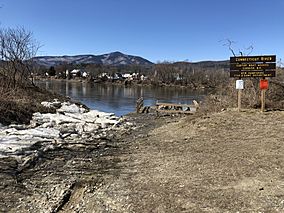Cornish Wildlife Management Area facts for kids
Quick facts for kids Cornish Wildlife Management Area |
|
|---|---|

Connecticut River boat access after ice-out, 2019. Mount Ascutney in Vermont in the background.
|
|
| Nearest town | Cornish, New Hampshire |
| Governing body | New Hampshire Fish & Game Department |
The Cornish Wildlife Management Area is a special natural spot in Cornish, New Hampshire. It's one of 124 Wildlife Management Areas (WMAs) in the state. This area is about 29 acres (120,000 m2; 12 ha) big. That's like 22 football fields! It's a place where nature is protected and people can enjoy the outdoors.
Contents
History of the Area
The Cornish Wildlife Management Area was bought in 1972. The main reason for buying it was to give people a good place to go fishing in the Connecticut River. A boat ramp was built on the property in 1974, making it easier for people to get their boats into the water.
Over the years, other land nearby has also been protected. This includes farms along New Hampshire Route 12A in Cornish. Private landowners have set up special agreements to keep these lands as farms for future generations. The Cornish Wildlife Management Area and the Saint-Gaudens National Historic Site also help protect land in this beautiful area.
What are Wildlife Management Areas?
Wildlife Management Areas, or WMAs, are special places set aside by the state. Their main goals are to protect and improve homes for wildlife. They also offer fun outdoor activities for people.
Activities You Can Do
- Hunting: In some areas, people can hunt during specific seasons.
- Fishing: Many WMAs, like Cornish, are great for fishing.
- Trapping: This is allowed only with a special permit.
- Wildlife Watching: You can often see many different animals and birds. It's a great place to observe nature!
How WMAs Are Funded
WMAs get help from the United States government. This funding comes from a law called the Dingell–Johnson Act. It's also known as the Federal Aid in Sport Fish Restoration Act. This law, passed in 1950, helps states pay for projects that restore fish and manage them. It also helps with other wildlife projects.

